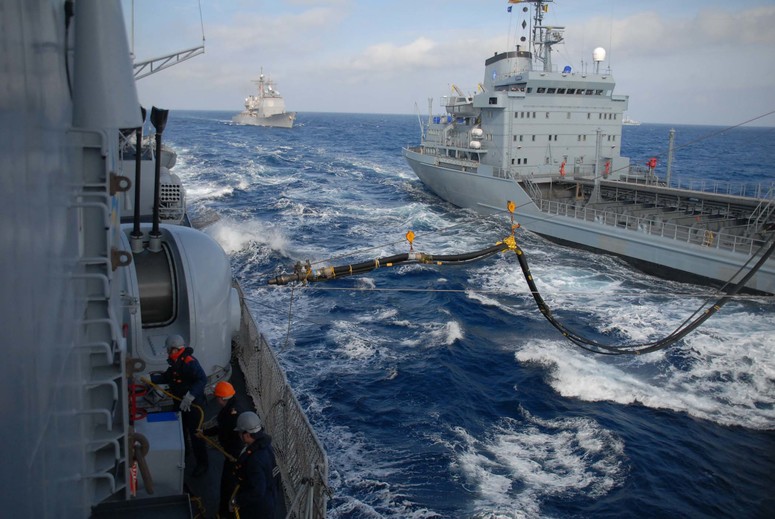The collective security system has for a while been the primary legal basis connected to maritime interception operations. And despite other legal frameworks that have emerged or MIO, the collective security system remains one of the most important legal bases for MIO. In 2011, the UN Security Council authorized military enforcement measures against the Qaddafi-regime in Libya and is still facilitating counter-piracy operations off the coast of Somalia. Maritime enforcement measures mandated by the UNSC can be divided into two types. The first type is the authorization of UN-mandated maritime embargo operations (MEO).
MEO are specifically focused on the enforcement of economic sanctions at sea which are adopted by the UNSC. The second type of maritime enforcement measures by the UNSC are measures that authorize the use of armed force which is not specifically related to economic sanctions under Article 41 of the UN Charter. This is the case when the UNSC authorizes all necessary means to enforce a UN mandate, which, translated to actual military operations, could involve a MIO. These two types may also exist concurrently in one military campaign. During the operations with regard to Libya in 2011, naval forces were for example used both as assets to conduct a maritime embargo operation and to conduct operations to fulfil the mandate of use all necessary means to protect civilians.
Maritime enforcement measures adopted by the UNSC are often referred to as “UN-mandated” maritime interception operations. In fact, “UN-mandated” refers to the command and control under which the operations are carried out. Carvalho de Oliveira has made a clear distinction between so-called UN-mandated and UN-controlled naval operations. With the first, he refers to the fact that; ‘The UN issues the resolutions but leaves the operational control in the hands of States, regional organizations or international coalitions’. With the latter, he refers to operations in which, ‘The Secretary-General assumes direct control of operations.’ Maritime interception operations based on the UN collective security system can include both UN-mandated and UN-controlled operations. To illustrate, the 2011 operations with regard to Libya in 2011 were UN-mandated because the UNSC authorized military operations that were operationally controlled by NATO (Unified Protector) and also for a short time by a coalition of States (Odyssey Dawn). MIO conducted in the context of UNIFIL are UN-controlled as it is under the operational control of the UN itself. Interestingly, this is the only naval operation that has have ever been directly controlled by the UN itself. Although the MIF operations with regard to Iraq are sometimes called ‘UNMIF’ and parts of the Korea War naval operations have been referred to as UNBEF (United Nations Blockading and Escorting Force), neither of them were under actual operational control of the UN itself. These names, however, must be seen in the context of the period in which they were conducted and refer to the fact that they were sanctioned by the UN through a UN resolution. This chapter will first briefly introduce the UN collective security system and will then consider the two types of maritime enforcement measures that can be mandated by the UN Security Council.
The UN collective security system is the legal basis for the UNSC to exercise its powers under Chapter VII of the UN Charter. The system takes as the obvious point of departure the use of force prohibition ex Article 2(4) of the UN Charter and provides for a graduated response for non-military and/or military measures to restore international peace and security. The system revolves around Chapters VI and VII of the UN Charter. Chapter VI concerns the peaceful settlement of disputes and Chapter VII includes taking coercive measures including the use of armed force. The essential difference between Chapter VI and VII is that measures taken under Chapter VI do not include coercive powers, whereas measures taken by the UNSC under Chapter VII, through Article 25 of the UN Charter, may be binding in nature. The key articles in Chapter VII are Articles 39, 41 and 42. Article 39 of the Charter is the obligatory stepping stone for taking coercive measures under Chapter VII. When a threat to peace, breach to peace or act of aggression exists, this article opens the door to the authorities that are contained in Articles 41 and 42 of the UN Charter.
Based on Article 41, the UNSC can take non-military measures, such as economic sanctions. If these measures prove to be or would be inadequate under the circumstances to deal with the issue at hand, the UNSC can decide to take measures based on Article 42, which provides authority to make use of armed force to restore international peace and security. Although only Article 42 allows for the use of armed force, that is not to say that under Chapter VI and the other articles of Chapter VII no military forces can be deployed. Clearly, this has often been the case. Therefore one cannot say that the deployment of military forces by itself amounts to an Article 42-operation. Forces deployed under Chapter VI are usually called upon within the context of UN peacekeeping operations and have particular features in authority and mandate. In particular, such forces need the consent of a State to operate on their territory, are required to adhere to the principle of impartiality and are restricted to self-defence when using force.9 Force deployed under Chapter VII of the UN Charter is often categorized as a peace-enforcing operation that bears a different legal feature than ‘Chapter VI operations’ in the sense that they do not need the consent of the target State, can be authorized to use force and are not necessarily impartial.

